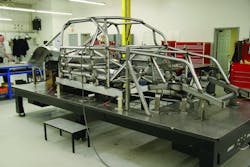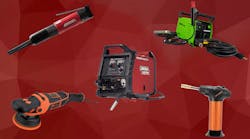For our racing issue, we visited the fabrication shop at Richard Childress Racing (RCR) in the town of Welcome, N.C. RCR is one of the largest competitors in NASCAR, and this year they are fielding four teams in the Sprint Cup Series, two in the Camping World Truck Series and two more in the ARCA Racing Series. Considering they build their cars from scratch, and that each team needs more than a dozen cars per season, the fabrication shop is a very busy place.
A rare opportunity
We were met by David Hart, Director of Corporate Communications and our guide for the day. As we entered the front room of the fab shop, he explained that it’s the last stop before the cars are loaded onto the transporter. Here the cars are parked on a perfectly flat surface and the prep crew completes the initial suspension set-up for the specific track being raced that weekend. The day we visited, they were prepping for a rare test session at Daytona. Why is that rare?
To control costs and level out the competition, NASCAR does not allow testing. They enforce this by owning all the tires, which are only available on race weekends and must be returned to the tire shop before leaving the track. Since it doesn’t make sense to test with any other tire, race weekend is the only time a team can test drive their racecars.
However this year, NASCAR allowed one week of testing at Daytona before the beginning of the season. That’s because the track has been resurfaced, and Goodyear, the exclusive tire supplier for all Cup races, needed to test various compounds to know what they should bring on race weekend. So even though it was still weeks before the first race of the season, the fab shop had to have some cars ready early. Like we said, it’s a busy place.
A smaller box
The fab shop builds roughly 14 cars per Cup team per year, plus the cars and trucks for all their other teams. This makes them a small-scale production company, and their tools and techniques are optimized to hand-build the same car time after time. The goal is to be able to build the exact same car each time, but that’s not always what they do.
When NASCAR introduced the Car of Tomorrow (COT) in 2008, one goal was to reduce a team’s costs by making it possible to campaign the same car at the high-bank super-speedway in Daytona and at the flat half-mile oval in Bristol. In theory that’s possible, but at this level of competition, Hart said all that really did was “make the box smaller.” He explained that, just like in the production car world, when you’re trying to build the same exact car time after time, there will always be one that is just a bit faster than the rest. If you have the ability to measure the smallest of differences, you eventually learn why. This gives you a ‘box,’ a set of variables you can adjust to optimize a car for a particular track. “Our smart guys get paid really good money to work within that very small box,” said Hart.
To get an idea of the size of that box, keep in mind that aerodynamics plays a major role in the car’s handling and top speed, and that aerodynamics may be different at different race tracks. Before welding a body panel into place, the technicians at RCR use information from a set of GPS receivers located inside the shop to make sure the panel is located properly.
As a result of chasing such tiny differences, RCR now builds almost as many Cup cars per season as they did before. Hart indicated that everyone seems to treat this as just another part of the challenge, and they feel the improvement in driver safety was worth the cost.
Who are these guys?
The people working in this shop started the same way as any other tech in the industry. The older guys (they’re all men) tend to have a varied background, usually including time in the service bay. More than a few of the most senior leaders in many racing organizations started out working at a local racetrack, maybe pushing a broom or selling peanuts, including Richard Childress himself.
Younger guys are more likely to have started with tech school and moved quickly (if not immediately) into racing. For many of them, that school was NASCAR Tech, one of the advanced programs offered at Universal Technical Institute’s Mooresville, N.C. campus. However, Hart noted that there’s still a place for a new guy with the appropriate experience but no formal education, typically in the engine tear-down room.
The one thing everyone has in common, said Hart, is that “they share a passion for racing.” During the racing season, up to 140 of RCR’s employees are at the track every weekend. Many of the remaining 350 are at a local track, either racing their own car or working with a friend’s team. Hart said that, for people working at RCR, “It’s not a job, it’s a lifestyle.”
Building a Cup car is a blend of science and art that utilizes an extreme range of technologies and talents. At the high-tech end is digitizing equipment that can measure the dimensions of anything down to 2 microns (0.002mm, or 0.0000787 in.), or the Global Positioning System mentioned earlier. At the other end of the technology spectrum, each body panel starts as a flat piece of sheet metal and is formed by hand on an English wheel, a tool developed over 700 years ago for making armor. And like that suit of armor, a racecar is also a work of art made with a man’s hands, eyes, brain and passion: still and always the ultimate tools.


